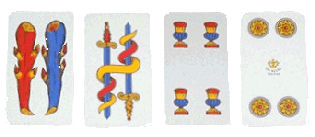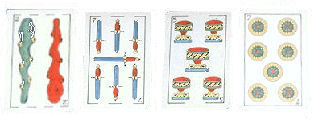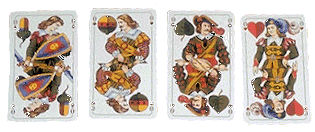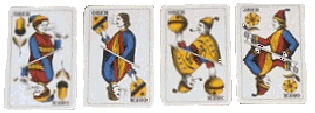This page offers general information about playing card suits in Europe.
It is thought that decks divided into "suits" came to Europe in the 15th century. At first there were no standard suits, but by the late 15th century suit standards began to appear. The picture on the left illustrates the French suit symbols and colors that are familar indicators to many people around the world today. Not only are these suit symbols known in France, but in all parts of the world. These symbols and colors became widely used in the 16th and 17th century probably because they were easier to incorporate in graphic production than the suit symbols and colors of playing cards from other countries.
These same suit symbols were adopted by the British in the 16th century and thus were also used throughout the British empire. Since both the British and the French settled North America, these are the card symbols that appear on cards used in the United States and Canada. Thus, this suit pattern is now known as the "Anglo-American" pattern and the "letters" or indicators on these cards are an English Language version.
On certain decks made in France, language indicators vary from the Anglo-American deck. With respect to the picture cards, the king would feature an "R" for Roi, and a queen would feature a "D" for Dame, for example. With respect the suit indictors on a French deck, the "spade" suit is called pike, the "diamond" suit is carreau, the "club" suit is trefle, and the "heart" suit is coeur. (See the French playing card page in this Section for examples.)

In Italy and Spain, which were also introduced to playing cards in the 15th century, different sets of suit indicators became popular on cards in those countries. The picture on the right is from an Italian deck. The pictures on the suits are "clubs", "swords", "cups", and "coins" respectively. However, people in northern Italy may use French suited decks for some games. A card box will indicate regional variations and which suit symbols and pictures are used on a deck, i.e. - Bergamo, Brescia, Roma, Trento. Spanish suit symbols are very similar to the Italian suits, but there are some differences.

This second picture on the right is of the Spanish suits. For example, the "clubs" of the Spanish suit are usually more "natural" than Italian "clubs". The Spanish "cups" are designed differently from the Italian "cups". However, both the Italian and the Spanish suit symbols are similar enough to have playing card scholars give them the collective name - the Latin Suits. Within Spain, there are many regional differences which are reflected in the decks of cards for sale - regional differences indicate which suit symbols and pictures are used on a deck, i.e. - Adaluza, Aragonesa, Bartolome, Basche, Catalunya, Espagnole, Galicia. Since the Spainish empire included Mexico and Latin America, Spanish suited cards can be found in use in these countries today.

In Germany, the card game that is played determines the type of deck that will be used - and all German decks are not alike. (See the page on Germany in this section for different decks.) On the left is a picture of German suit symbols. The first card features the "acorn" or in German the Eichel suit. The second card is of the "bells" suit or Schellen. Although the third card appears to look like a "spade", it is a "leaf", sometimes called a "green" and in German known as the Grun or Blatt suit. The fourth suit is the "hearts" suit or Herz. Germany produces playing cards for many different countries today. Some of these exports are made with the suit symbols illustrated, some exported decks use other symbols. Suiss suit symbols are somewhat similar to the German suits, but there are differences.

The first card in the Swiss deck pictured in the second photograph on the left is also known as the "acorn" or Eichel suit. The second card is the "shield" suit or Schilten. The third card is the "bells" suit or Schellen. Finally, the fourth card is in the "roses" suit or Rosen. People in Swizerland who play a game (or a number of related games) called Jass will use a deck with these suit symbols. However, people living near the French border may use decks with the French suit indicators, while people living near the Italian border may use Latin suited cards.
To make matters more interesting regarding suit symbols and indicators, there are large variations today since card manufacturers not only make playing cards for their own country, and regional groups within their country, but also make decks for foreigners living in that country. Manufacturers also make special decks for card collectors (a very popular hobby), special decks for special games, travel sized decks, commemorative decks, historic decks, and also decks for export to countries which don't make their own playing cards.
This page only begins to "scratch" the surface of the information regarding European playing card suit patterns. Not only are the patterns used on playing cards in Asian countries quite different from European playing cards, but the size and shape of Asian playing cards vary from country to country.
NOTE: This page was originally created and posted on the Web on April 6, 1998. Subsequently it has been modified and periodically updated. Last update: June 8, 2010